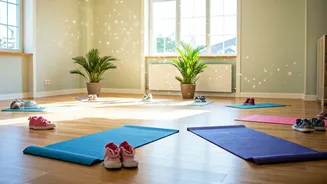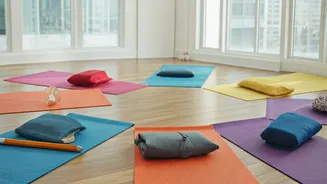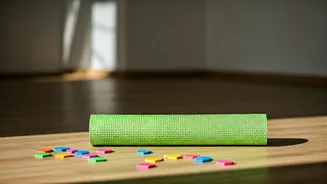Introduction to Yoga
Yoga, an ancient practice, is increasingly recognized for its holistic benefits, particularly for children. It's more than just physical postures; it is a blend
of physical activity, mindfulness, and breathing techniques. Yoga helps children in numerous ways. For instance, yoga enhances their overall physical health by promoting flexibility, strength, and balance, which helps improve posture and coordination. Moreover, it significantly boosts concentration and memory by fostering a calm mind. In today's demanding world, children face immense pressure, and yoga gives them invaluable tools to handle stress and enhance their emotional well-being. Introducing yoga to children at a young age equips them with lifelong skills, setting a foundation for a healthier and more balanced life.
Mountain Pose (Tadasana)
Tadasana, or Mountain Pose, is an excellent starting point for any yoga session. It’s a foundational pose, simple yet powerful, promoting a sense of groundedness and stability. To perform this asana, children should stand tall with their feet firmly planted on the ground, either together or slightly apart. Encourage them to engage their core muscles, drawing their shoulders back and down while keeping their arms relaxed at their sides. They should breathe deeply, feeling the stretch from the crown of their head to the heels of their feet. Mountain Pose cultivates body awareness and helps children become more mindful of their posture, which is crucial for building a strong foundation. This pose teaches them to center their attention and connect with their bodies. Regular practice of Tadasana also enhances balance and increases their concentration ability.
Tree Pose (Vrksasana)
Vrksasana, or Tree Pose, is a balancing posture that enhances focus and steadiness. To begin, instruct the children to stand tall in Tadasana. They should then shift their weight to one leg and gently place the sole of the other foot either on the inner thigh or calf of the standing leg, avoiding the knee. Ensure they keep their hands in prayer position in front of the chest, and slowly raise their arms overhead like the branches of a tree. They should maintain their gaze on a fixed point to prevent losing balance, reminding them to stay focused and calm. This pose challenges their equilibrium, honing their ability to concentrate and stay present. Tree Pose also improves their overall body awareness and promotes mental clarity. This asana can be practiced daily to help kids build mental strength.
Warrior II (Virabhadrasana II)
Virabhadrasana II, also known as Warrior II, is a dynamic pose that builds strength and promotes confidence. Instruct the children to begin by standing with their feet wide apart, about three to four feet. Turn one foot out to the side, pointing it away from their body, and bend the knee of the same leg to a 90-degree angle, ensuring their knee is aligned over their ankle. Extend their arms out to the sides, parallel to the ground, with their palms facing down. Their gaze should be directed over their front hand, maintaining a strong, steady posture. This pose encourages them to become mentally focused by promoting strength, stability, and mindfulness. It teaches them to remain centered and determined, no matter the challenges they face. Regular practice of Warrior II enhances physical endurance.
Downward Dog (Adho Mukha Svanasana)
Adho Mukha Svanasana, or Downward-Facing Dog, is a versatile pose with numerous benefits, including increased blood flow to the brain, which enhances focus. To begin, have the children start on their hands and knees, with their hands shoulder-width apart and knees hip-width apart. Then, they should tuck their toes and lift their hips toward the ceiling, forming an inverted V-shape with their body. They can lengthen their spine, pushing their heels towards the ground. This pose offers a gentle stretch and promotes mental clarity. It's a great exercise for building strength, improving posture, and encouraging children to calm down. Downward Dog is particularly beneficial for alleviating stress and enhancing overall concentration.
Cobra Pose (Bhujangasana)
Bhujangasana, or Cobra Pose, stretches the spine and stimulates the mind, boosting focus and awareness. To practice this, children should lie on their stomach with their hands placed under their shoulders. They should keep their elbows close to their body, gently lift their chest off the ground, using their back muscles. The children should avoid straining their neck and look straight ahead or slightly upward. This pose enhances blood circulation and improves overall posture. Cobra Pose opens the chest and stimulates the abdominal organs, promoting mental clarity and reducing fatigue. This asana encourages confidence and a sense of self-assuredness, helping children approach challenges with confidence.
Child's Pose (Balasana)
Balasana, or Child's Pose, is a calming and restorative posture that can help reduce stress and improve focus. Have the children kneel on the floor with their knees together or slightly apart. They should then bend forward, resting their forehead on the ground. Encourage them to extend their arms forward or place them alongside their body. Deep breathing while in Child’s Pose can have a relaxing effect on the nervous system. Child's Pose can provide a safe space for children to pause and reflect. This pose is especially effective for reducing anxiety and promoting relaxation. It also allows the body and mind to recharge, making it an excellent exercise for improving concentration and emotional well-being.
Bridge Pose (Setu Bandhasana)
Setu Bandhasana, or Bridge Pose, is an energizing posture that opens the chest and strengthens the back, which can indirectly enhance concentration by improving blood flow to the brain. To do this, have the children lie on their backs with their knees bent and feet flat on the floor, hip-width apart. They should place their arms at their sides, palms facing down. Using their legs and core, they should lift their hips off the ground, keeping their shoulders on the floor. While holding the pose, children are encouraged to breathe deeply and evenly. This pose helps improve blood circulation, reduces stress, and stimulates the thyroid gland, which promotes a feeling of alertness and vitality. The Bridge Pose can be practiced regularly to help increase awareness.
Boat Pose (Paripurna Navasana)
Paripurna Navasana, or Boat Pose, is a challenging yet highly beneficial pose that builds core strength and improves balance, promoting focus. Children should sit with their knees bent and feet flat on the floor. They should then lean back slightly, lifting their feet off the ground, while keeping their back straight. Ideally, their shins should be parallel to the ground. They can extend their arms forward, parallel to the ground, keeping their gaze focused. This pose requires concentration and cultivates mental resilience. It improves core strength and digestion. Boat Pose challenges their ability to concentrate and maintain equilibrium. It encourages self-discipline, which in turn benefits memory and cognitive functions.
Butterfly Pose (Baddha Konasana)
Baddha Konasana, or Butterfly Pose, is a gentle hip-opening pose that helps calm the mind and reduce stress. To begin, children should sit with their back straight, bringing the soles of their feet together, and letting their knees fall open to the sides. They should hold their feet with their hands and gently flap their knees up and down like the wings of a butterfly. This pose improves flexibility and helps release tension in the hips and lower back, promoting relaxation and mental clarity. Butterfly Pose encourages deep breathing, which is essential for improving focus and concentration. This asana can be practiced to promote a sense of calm and well-being, enhancing their ability to focus and learn. Regular practice can help reduce anxiety and improve overall cognitive function.













